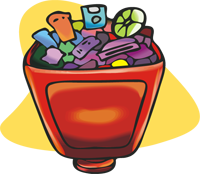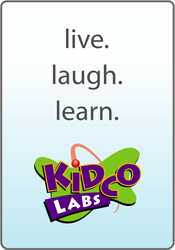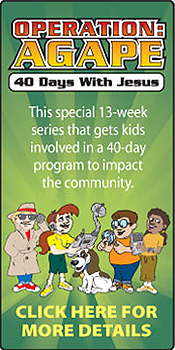 |
 |
 |
 |
 |
THE DYNAMICS OF ENVIRONMENT

Setting the right environment can make or break your ministry.
by David Goebelbecker, Kidco Labs

When it comes to any kind of group meeting, environment means everything. The right setting
serves as a catalyst that can make or break everything else that happens. With the right
environment, concerns are left at the door, inhibitions are washed away and good communication
can take place. The end result is that people get closer or are changed in some way.
However, the wrong environment can actually have the opposite effect.

For children and children's ministry, the right environment is even more crucial.
Children are used to being surrounded by visual stimuli. They have been conditioned by television
that flashes images at them and sounds that screen attention from their gaming systems. The result
is that they have learned how to receive information faster and from more than one source, which
can be a blessing and a burden for those who teach.
|
 |
 |

The blessing is that there are more resources available in a variety of media to help children
get the message, but that means that a burden is placed on the educators to try to find new and
innovative ways to keep up with the speed kids learn today. Another challenge is finding ways
to control the environment to minimize distractions so that children can get the most out of their time.

|
 |
 |
 |
UNDERSTANDING ZONES

In any classroom setting, there are four zones or areas that come to mind immediately—teaching, seating, check-in
or greeting areas, and storage. These are standard areas found in most classrooms regardless of age. For children's church,
there are several other areas that you also need to be aware of. Each of these corresponds to other aspects of a standard
children's church and are more of a mindset than a physical area in the classroom. They include a game/activity zone,
a praise/worship zone and lighting/sound zone.

Regardless of your specific church layout and situation, these environmental zones are totally in your control and can
be adapted to maximize your teaching effectiveness. It is all a matter of awareness, a little experimentation and careful
planning. Let's go through each zone and talk about what they are for and how they can be adapted for the best results.

THE TEACHING ZONE

If you are a teacher, it goes without saying that you will need a place to do it. Most people do this
by setting up a podium—whether this is a music stand, a pulpit or a small table—and it is situated at one
end of the room. It is the epitome of a classroom setting, but it may not always be the best approach for teaching
with children. Rather than setting up a stationary place to stand and teach, think of the entire classroom as
a teaching zone and use it all to its fullest potential. Here are some helpful suggestions.

|
 |
 |
Use the aisles, and move around as you are teaching. If you have a stage or platform area, come down from that
area and move closer to the children and look them in the eye. You can even use a rolling cart or table with
wheels to bring objects closer to the children. Moving around and giving the children different things to look
at and focus on helps to minimize distractions.

IMPORTANT NOTE: Children spend 5 days a week in a classroom with a teacher talking from one location at the front
of the class. By doing things differently, you will add interest and prevent boredom.

|
 |
 |
 |
THE SEATING ZONE

In every classroom, this is the area that usually takes up most of the available space and
is also the most taken for granted. Children do need a place to sit during the classroom, but it doesn't
always have to be in chairs or in the middle of the classroom. If you want to try something different,
try setting the chairs as two long rows facing each other with large center aisle to be used for teaching
or have the chairs circle around a central zone that you can use for games, teaching and praise/worship
times. If you are looking for easy ways to get more space for games and activities, get rid of the chairs
all together and stack them in a corner and have the children sit on the floor in any arrangement that is
conducive to each lesson element.

GREETING/CHECK-IN ZONE

Since this is the first thing that every child sees—and the parents too—there are things that
should be considered to increase the effectiveness of this zone. First, it should communicate to everyone
that enters. It should be welcoming and let each visitor know where they are. This can be done with signage,
bulletin boards, and information tables, but more importantly, it should have real people with friendly smiles
to shake hands, make jokes and warmly greet each person. At the beginning of every class time as well as at the end,
it is imperative that a few leaders are prepared to watch over this area and manage whatever needs arise to
minimize distractions from the classroom events. This is important at the beginning, but even more at the end
as children are ready to go.

Although it may seem obvious, it's important that this area is not in the direct line of sight of children once
they are in the classroom. First, because once the children are in the room, their focus and attention should be
to the lesson and to each other. Second, it helps make a better transition from parent care to classroom time.
Lastly, it also helps to minimize distractions for any children that need to leave the classroom before the class
time is over.

|
 |
 |
THE STORAGE ZONE

In many classes, closets or shelving provide storage areas for supplies. In some cases, like a smaller church
that meet in temporary locations, storage bins that are brought along do the job. Regardless of where your
supplies are stored, the storage area should never get the attention during class. One of the biggest
distractions to children is when a teach leaves the main class to go and get supplies or gather materials
for the next classroom event.

|
 |
 |
 |
All materials for each classroom should be pulled out and staged long before
the class starts. This helps the flow of the teaching time as you transition from one event to another and
maintains the focus on the classroom activities. Basically, storage is necessary in any classroom, but should
be invisible to the children during class time, so anything that can be done to hide this area should be taken.

GAMES & ACTIVITY/ PRAISE & WORSHIP ZONES

During your lesson plan, there are times for sitting still and there are times for getting up and moving around.
By allowing the children to change their physical position, their focus and attention can be shifted more strongly
on the next activity while removing fidgetiness. You have several options to allow the children space to move around.
One way is to create a large open area at the front of the classroom that can be used as an activity zone. This can
then be used for praise and worship, teaching, games or even altar time and prayer at the end of the service. This
space should be visible from any seated position.

Other ways to create activity zones is to allow a wider aisle between chairs, or to push them out of the way
altogether toward the end of the class time for closing activities and games that allow the children to play
in a planned group activity while waiting for their parents to come. The more space you can make, the better
chance you have of getting every child involved. If you don't have enough room for all the children, then select
a group of children from week to week and make it a special privilege to "enter the zone". It will then become
something that children desire and look forward to when it's their turn. You may even choose to take the classroom
out of the classroom by going outside or to another space, like a basketball court or indoor gym.

LIGHTING & SOUND ZONE

|
 |
 |
The amount of control in these zones does vary depending on your physical location and ministry situation. In
smaller churches and ministries that do not have a dedicated location or classroom, setting up lighting each week
can be a burden. The goal with lighting is to make sure that the active zone received the most light. As with any
audience, the eye tends to focus on what is in the spotlight, so keep it in mind as you are working in your space.

|
 |
 |
 |
Unlike lighting, the sound zone is always at your control. Sounds are important to us and many times can be taken
for granted. You should have a good variety of music available and someone that is designated to manage it at all
times. At the start of the service, there should be high-energy music playing that the children enjoy. The music
helps set a tone for the children and helps them connect with everything that is to come. Your praise and worship
music should also be something that is geared to your children and engage the children to be a willing participant.
There are many different worship resources out there. If you are looking for ideas, go to the Resources area and
click on 'worship resources'.

During games and activities, music can also be a powerful tool. High-energy music during a game or activity helps
raise the level of excitement and helps promote more interaction in the event. It is also good for parent to see
and hear that their children are having a good time when they come to collect their child at the end of the service.

MAKING ZONES WORK FOR YOU

There is no formula or set method to make the most of classroom zones. The key to maximizing your classroom zones
is awareness. Once you know the zones that make up your classroom, it is time to observe and evaluate how your
classroom is currently being used. If you feel that something isn't working, try something different and see how
the children respond. You will also want to discuss the changes with your leaders and devise ways to facilitate
the lesson segments in the new environment. They may also have some good suggestions that can help improve the effectiveness
of lesson segments.

Once you've tried out your new idea in a real classroom setting, evaluate it again with the leaders to see if it
helped or hindered the teaching and what else could be done to make things work better. Remember that whatever you
try will take more than one attempt to be effective, but any change is good. It can be the catalyst to a stronger
ministry, add new excitement and a level of freshness for the children as well as promote more new and creative ideas that
can stoke the fires inside and stimulate a stronger walk with God. After all, that is what we all are trying to
achieve in the end.
|
 |
|
 |
 |
 |




Articles Overview

Powerful Praise and Worship

The Science of Leading Great Games

Creating An Effective Environment

Leading Children To Christ

Creating Custom T-shirts

Making Custom Hats

Using Fonts Effectively

Add A Little F.U.E.L. To Your Lesson

Is Your Ministry Running On All Cylinders?

Live. Laugh. Learn.



Resources Overview

Leader Resources

Game Zone

Worship Resources

Download Center

Articles


|
 |

